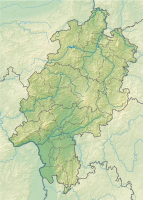Stallions
|
Stallions nature reserve
|
||
|
Stream on the western edge of the nature reserve (2013) |
||
| location | Rodgau and Obertshausen , Hesse , Germany | |
| surface | 8.28 hectares | |
| Identifier | 1438002 | |
| WDPA ID | 81867 | |
| Geographical location | 50 ° 3 ' N , 8 ° 51' E | |
|
|
||
| Setup date | 19 ?? | |
| administration | Lower nature conservation authority in the Offenbach district | |
The Hengster nature reserve (NSG identification 1438002) is located in the Offenbach district in Hesse . It covers around eight hectares of forest, which is mainly located in the urban area of Rodgau and a small part in the Obertshausen area. It is considered to be one of the oldest nature reserves in Hesse and Germany.
Area description
The nature reserve is located in a larger agricultural and forestry area between the localities of Obertshausen , Weiskirchen , Rembrücken and Heusenstamm . In the north it borders on the bypass road along the federal highway 3 , which was built in the 1950s. Other surrounding areas are located in the large landscape protection area of the Offenbach district (LSG identification 2438001).
The stallion is a former moorland area that was known nationwide at the beginning of the 20th century due to its remarkable flora. The area was discovered as a "botanical treasure chest" as early as 1821. It attracted researchers from all over the world who found a moor landscape that reached into the so-called cross hole. Water-permeable drift and dune sands made the soil poor in nutrients. A number of raised bog plants were to be found, including numerous rarities, u. a. Orchids . Until 1995 the sundew , a carnivorous plant, could be detected in the area. Many other animal and plant species that are now extinct or threatened also flourished.
Around 1930 several trenches were dug for agriculture and the area drained . In the meantime, at the beginning of the 21st century, the stallion is largely a dry quarry forest with alder and birch trees, which is primarily of historical importance.
A permanent exhibition is dedicated to the area in the Obertshausen local history museum. The history of the stallion from 1884 to 1969 was documented in two books.
Protection purpose
The purpose of the NSG designation is to protect the area with its rare plant species from interference.
In addition to the drainage ditches, the construction of the Frankfurt - Würzburg motorway and the nearby Lämmerhecke pumping station had an increasing drainage effect in the 1950s. This led to further drying out of the area, and as a result the succession of the once boggy wetland through birch and alder continued. In 1983 the nature conservation authority could not decide to delete the NSG. Today there is a quarry forest-like, dry alder-birch forest, and so the former “Botanical Treasure Chest” ekes out its existence as a warning “nature conservation ruin”.
See also
literature
- Eikamp, H .; Kühn, K .; Zimmermann, KH (1987): The Hengster nature reserve through the ages. NAOM self-published, Obertshausen.
- ders .: (1984): There is not much left of the splendor in the stallion. Drainage is the "cause of death" for nature reserves. - OFFENBACH-POST, 10:19 am; Offenbach a. M.
- Goll, Fr. (1927): The stallion, a Hessian nature reserve. Schulbote für Hessen 68, pp. 210–211.
- Grau, Josef (1928): The Hessian state nature reserve "Hengster" in the Offenbach a. M. Volk and Scholle 6, pp. 211-216.
- Karafiat, H. (1979): Nature reserve "Hengster" , report by RP Darmstadt (unpublished).
Web links
Individual evidence
- ↑ a b botany. In: nabu-obertshausen.de. Retrieved May 17, 2016 .
- ↑ cf. Offenbach Post: Stallion used to be moorland. Retrieved September 23, 2018 .
- ↑ nature reserves. In: Kreis-offenbach.de. Retrieved September 20, 2018 .
- ↑ cf. HGON: stallions. Retrieved September 23, 2018 .
Remarks
- ↑ a b There are contradicting information on the year of the first identification between 1906 (including NABU Rodgau ) and 1940 ( BfN : www.geodienste.bfn.de/schutzgebiete). Plausible appears in 1923 ( EUNIS entry ); see. also literature section and the publications from the 1920s with “nature reserve” in the title. - Please clarify with usable evidence. (exact date of the first NSG prescription?)


